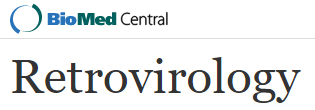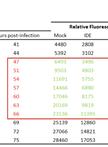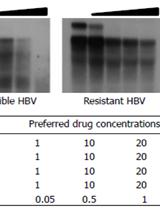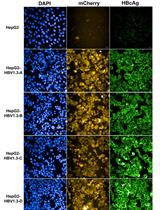- EN - English
- CN - 中文
Isolation of Exosomes from Semen for in vitro Uptake and HIV-1 Infection Assays
从精液中分离外来体用于体外摄取和HIV-1感染测定
发布: 2017年04月05日第7卷第7期 DOI: 10.21769/BioProtoc.2216 浏览次数: 12712
评审: Andrea IntroiniAnonymous reviewer(s)
Abstract
Exosomes are membranous extracellular nanovesicles of endocytic origin. Exosomes are known to carry host and pathogen-derived genomic, proteomic, lipidomic cargos and other extraneous molecules. Exosomes are secreted by diverse cell types into the extracellular milieu and are subsequently internalized by recipient neighboring or distal cells. Upon internalization, exosomes condition recipient cells by donating their cargos and/or activating various signal transduction pathways, consequently regulating physiological and pathophysiological processes. Exosomes facilitate intercellular communication, modulate cellular phenotype, and regulate microbial pathogenesis. We have previously shown that semen exosomes (SE) inhibit HIV-1 replication in various cell types. Here, we describe detailed protocols for characterizing SE. This protocol can be adapted or modified and used for evaluation of other extracellular vesicles of interest.
Keywords: Semen (精液)Background
Exosomes are membranous nanovesicles originating as a result of inward budding of endosomal membranes within the late endosomal compartment of a multitude of cell types (Simons and Raposo, 2009). Exosomes are released by many cell types (Iglesias et al., 2012) into the extracellular milieu and are found in biological fluids including blood (Kaur et al., 2014) urine (Li et al., 2013) saliva (Madison et al., 2015) and breast milk (Madison et al., 2014; Naslund et al., 2014). Human semen contains a heterogenous population of nanovesicles (Madison et al., 2014; Madison et al., 2015) produced by tissues of the male genital tract including prostate secretory acinar cells (Sahlen et al., 2002) and epididymal epithelial cells (Frenette et al., 2010) as well as cells of the vasa deferentia, testes, and the vesicular glands (Renneberg et al., 1997; Sullivan et al., 2005). The variability in the cells that secret exosomes is reflected in the composition and function of exosomes. Thus, exosomal cargo composition and function are regulated by many factors including the type and condition of the originating cell (Raposo and Stoorvogel, 2013), cellular environment, and for in vivo derived exosomes; the condition of the donor (Welch et al., 2017). Released exosomes when taken up by target cells transfer their cargo, including proteins (Iglesias et al., 2012; Charrier et al., 2014), miRNA (Shtam et al., 2013; Ong et al., 2014), and mRNA (Tomasoni et al., 2013; Madison et al., 2014; Madison et al., 2015) to the target cells. As a result, exosomes are known to be involved in modulation of host immune response (Kaur et al., 2014; Vojtech et al., 2014), and regulation of microbial pathogenesis (Li et al., 2013; Arenaccio et al., 2014; Madison et al., 2014; Naslund et al., 2014; Vojtech et al., 2014; Madison et al., 2015).
While progress has been made in the field of exosome biology, many protocols are contradictory in the most effective and efficient method of characterizing exosomes (Taylor and Shah, 2015). Here, we provide a detailed protocol for evaluating the function and physical properties of semen exosomes (Madison et al., 2014; Madison et al., 2015). This protocol lays the groundwork for evaluating other functional activities of semen exosomes, and for evaluating exosomes from other sources.
Materials and Reagents
- Pipette tips (any brand)
- 15 polypropylene conical plastic tubes (DOT SCIENTIFIC, PerformR®, catalog number: 416-PG )
- 50 ml polypropylene conical plastic tubes (DOT SCIENTIFIC, PerformR®, catalog number: 451-PG )
- 12 well tissue culture plate (CELLTREAT Scientific Products, catalog number: 229112 )
- 5 ml polystyrene round-bottom tubes (Corning, Falcon®, catalog number: 352052 )
- Microscope coverslip, 18 mm (Fisher Scientific, FisherbrandTM, catalog number: 12-545-100 )
- Coverslips (VWR, catalog number: 48382-041 )
- Microscope slides (Fisher Scientific, catalog number: 22-034-486 )
- 1.7 m microcentrifuge tube (DOT SCIENTIFIC, catalog number: RN1700-GMT )
- 96 well solid white flat-bottom polystyrene microplates (Corning, catalog number: 3917 )
- 96 well tissue culture plate (CELLTREAT Scientific Products, catalog number: 229196 )
- Disposable cuvettes (Eppendorf, catalog number: Z605050 )
- 1 ml disposable syringes (BD, catalog number: 309659 )
- 96 well tissue culture dishes
- U937 human monocytic cell line
- TZM-bl human vaginal epithelial cell line
- Jurkat human T lymphocyte cell line
- V428 (HPV-16 E6/E7 transformed human vaginal epithelial cell line)
- VK2 (HPV-16 E6/E7 transformed human vaginal epithelial cell line)
- Human semen
- Cell-free HIV-1 virus stock, replication competent
- ExoQuick (System Biosciences)
- Phosphate buffered saline, DPBS 1x; without CaCl2 and MgCl2 (Thermo Fisher Scientific, GibcoTM)
- Liposomes (Lipofectamine 2000) (Thermo Fisher Scientific, InvitrogenTM, catalog number: 11668019 )
- PKH67Green fluorescent kit (Sigma-Aldrich, catalog number: MINI67 )
- PKH26Red fluorescent kit (Sigma-Aldrich, catalog number: MINI26 )
- Fetal bovine serum (FBS) (Thermo Fisher Scientific, GibcoTM)
- Quick Start Bradford Protein Assay Kit 1 (Bio-Rad Laboratories, catalog number: 500-0201 )
- Roswell Park Memorial Institute (RPMI) 1640 (Thermo Fisher Scientific, GibcoTM)
- Penicillin/streptomycin (Thermo Fisher Scientific, GibcoTM)
- Sodium pyruvate (Thermo Fisher Scientific, GibcoTM)
- L-glutamine (Thermo Fisher Scientific, GibcoTM)
- Keratinocyte serum free media (KSFM) (Thermo Fisher Scientific)
- Human recombinant Epidermal Growth Factor 1-53 (Thermo Fisher Scientific)
- Bovine pituitary extract (BPE) (Thermo Fisher Scientific)
- 0.25% trypsin-EDTA, phenol red dissociation reagent (Thermo Fisher Scientific, GibcoTM, catalog number: 25200-056 )
- Collagen, type 1 from rat tail (Sigma-Aldrich, catalog number: C3867 )
- Paraformaldehyde (2%) (Fisher Scientific, catalog number: T353-500 )
- Vectashield antifade reagent with DAPI (Vector Laboratories, catalog number: H-1200 )
- Exosome-human CD63 Isolation/Detection (Thermo Fisher Scientific, InvitrogenTM, catalog number: 10606D )
- Albumin, bovine fraction V (BSA) (RPI, catalog number: A30075-100.0 )
- Anti-human CD63-FITC (BioLegend, catalog number: 353005 )
- Aldehyde/Sulfate latex beads (Thermo Fisher Scientific, Molecular ProbesTM, catalog number: A37301 )
- MHC-II monoclonal antibody
- Isotype control antibody (mouse IgG1)
- Glycine (RPI, catalog number: G36050-500.0 )
- Anti-human CD63-PE (BioLegend, catalog number: 353003 )
- Triton-X-100 (Sigma-Aldrich, catalog number: X100 )
- Acetylthiocholine chloride (Sigma-Aldrich, catalog number: A5626 )
- 5,5’-Dithiobis 2-nitrobenzoic acid (Sigma-Aldrich, catalog number: D8130 )
- Sodium carbonate, anhydrous (RPI, catalog number: S25025-500.0 )
- NuPAGE LDS sample buffer (4x) (Thermo Fisher Scientific, NovexTM, catalog number: NP0008 )
- NuPAGETM NovexTM 4-12% Bis-Tris Protein Gels, 1.5 mm, 10-well (Thermo Fisher Scientific, InvitrogenTM, catalog number: NP0335PK2 )
- NuPAGE MOPS SDS running buffer (20x) (Thermo Fisher Scientific, NovexTM, catalog number: NP0001 )
- Pierce Silver Stain Kit (Thermo Fisher Scientific, Thermo ScientificTM, catalog number: 24612 )
- RNeasy Mini Kit (QIAGEN, catalog number: 74104 )
- RNase-Free DNase Set (QIAGEN, catalog number: 79254 )
- High-capacity cDNA Reverse Transcription Kit (Thermo Fisher Scientific, Applied BiosystemsTM, catalog number: 4368814 )
- QuantiFast SYBR Green PCR Kit (QIAGEN, catalog number: 204054 )
- Agarose (RPI, catalog number: A20090 )
- Ethidium bromide solution (Bio-Rad Laboratories, catalog number: 1610433 )
- 1x TAE buffer
- Steady-Glo (Promega, catalog number: E2510 )
- NuPAGE sample reducing agent (10x) (Thermo Fisher Scientific, NovexTM, catalog number: NP0004 )
- MES (Sigma-Aldrich, catalog number: M2933 )
- 1 N NaOH (Avantor Performance Materials®, J.T.Baker®, catalog number: 563502 )
- Distilled water (any brand)
- Exosome-depleted FBS (Thermo Fisher Scientific, GibcoTM, catalog number: 26140079 )
- MTT reagent (Thermo Fisher Scientific, Molecular ProbesTM, catalog number: M6494 )
- Nonidet P-40 substitute (RPI, catalog number: N59000 )
- Hydrochloric acid (HCl), ACS reagent, 37% (Sigma-Aldrich, catalog number: 258148 )
- Isopropanol (Fisher Scientific, catalog number: A416-4 )
- Dulbecco’s modified Eagle medium (DMEM) (Thermo Fisher Scientific, GibcoTM)
- Exosome-depleted FBS (see Recipes)
- Lysing sample buffer for protein footprint (see Recipes)
- Storage buffer (see Recipes)
- MES buffer (see Recipes)
- FACS wash buffer (see Recipes)
- MTT reagent (see Recipes)
- MTT solvent (see Recipes)
Equipment
- Pipettes (any brand)
- Sterile tweezers (any brand)
- Centrifuge (Eppendorf, model: 5415 D)
- Ultracentrifuge (Beckman Coulter, model: Optima L-90K )
- SW40Ti rotor (Beckman Coulter, catalog number: 331362 )
- Polyallomer centrifuge tubes 14 x 89 mm for SW41Ti rotor (Beckman Coulter, catalog number: 344059 )
- 37 °C, 5% CO2 cell culture incubator (NuAire, model: NU-5510 )
- FACSCalibur flow cytometer (BD) (see Notes for laser and filter specifications)
- FACSVerse flow cytometer (BD) (see Notes for laser and filter specifications)
- FACSAria flow cytometer (BD) (see Notes for laser and filter specifications)
- Laser scanning confocal microscope (Nikon Instruments, model: Eclipse TE2000 )
- Magnetic separator for 1.7 ml tubes
- Rotating mixer
- Microplate reader (Tecan Trading, model: Infinite® M200 Pro )
- DynaPro Nanostar (Wyatt Technologies, model: DynaPro Nanostar )
- NanoSight LM10 (Malvern Instruments, model: NanoSight LM10 )
- NanoDrop spectrophotometer (Thermo Fisher Scientific)
- SW60 Ti rotor (Beckman Coulter, catalog number: 335649 )
- Polyallomer centrifuge tubes 11 x 60 mm for SW60Ti rotor (Beckman Coulter, catalog number: 355636 )
- 7500 fast real-time PCR system (Thermo Fisher Scientific, model: 7500 Fast Real-time PCR System )
- Luminometer (BioTek Instruments, model: Synergy H1 Hybrid Reader )
- Laminar flow hood
- SW32 Ti rotor (Beckman Coulter, model: 369650 )
- Polyallomer centrifuge tubes 25 x 89 mm for SW32Ti rotor (Beckman Coulter, catalog number: 344058 )
- pH meter (any brand)
- Gel running tank(Thermo Fisher Scientific, NovexTM, model: XCell SureLock® Mini-Cell , catalog number: EI0001)
- Sephacryl S300-HR 16/60 gel filtration prepacked column (GE Healthcare catalog number: 17-1167-01 )
- BioLogic DuoFlow Workstation (Bio-Rad Laboratories)
- BioLogic BioFrac fraction collector (Bio-Rad Laboratories)
- Gel electrophoresis horizontal apparatus (Bio-Rad Laboratories, model: Wide Mini-Sub Cell GT Cell, catalog number: 1704468EDU )
- Dry Block Heater for microcentrifuge tubes (Thermo Fisher Scientific)
Software
- FlowJo analysis software (TreeStar)
- BioLogic DuoFlow software version 5.3 (Bio-Rad Laboratories)
- Dynamics software (Wyatt Technology)
- NTA software (Malvern Instruments)
Procedure
文章信息
版权信息
© 2017 The Authors; exclusive licensee Bio-protocol LLC.
如何引用
Madison, M. N., Welch, J. L. and Okeoma, C. M. (2017). Isolation of Exosomes from Semen for in vitro Uptake and HIV-1 Infection Assays. Bio-protocol 7(7): e2216. DOI: 10.21769/BioProtoc.2216.
分类
免疫学 > 宿主防御 > 人
微生物学 > 微生物-宿主相互作用 > 体外实验模型 > 细胞系
细胞生物学 > 细胞器分离 > 外来体
您对这篇实验方法有问题吗?
在此处发布您的问题,我们将邀请本文作者来回答。同时,我们会将您的问题发布到Bio-protocol Exchange,以便寻求社区成员的帮助。
Share
Bluesky
X
Copy link













